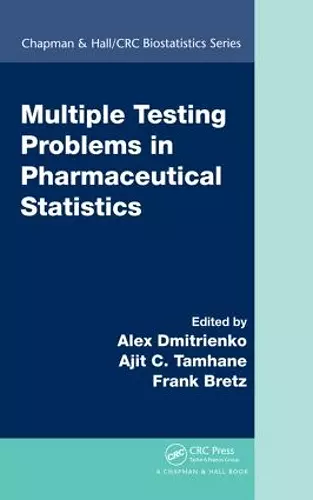Multiple Testing Problems in Pharmaceutical Statistics
Alex Dmitrienko editor Ajit C Tamhane editor Frank Bretz editor
Format:Hardback
Publisher:Taylor & Francis Inc
Published:8th Dec '09
Currently unavailable, and unfortunately no date known when it will be back
This hardback is available in another edition too:
- Paperback£45.99(9781032477701)

Useful Statistical Approaches for Addressing Multiplicity Issues
Includes practical examples from recent trials
Bringing together leading statisticians, scientists, and clinicians from the pharmaceutical industry, academia, and regulatory agencies, Multiple Testing Problems in Pharmaceutical Statisticsexplores the rapidly growing area of multiple comparison research with an emphasis on pharmaceutical applications. In each chapter, the expert contributors describe important multiplicity problems encountered in pre-clinical and clinical trial settings.
The book begins with a broad introduction from a regulatory perspective to different types of multiplicity problems that commonly arise in confirmatory controlled clinical trials, before giving an overview of the concepts, principles, and procedures of multiple testing. It then presents statistical methods for analyzing clinical dose response studies that compare several dose levels with a control as well as statistical methods for analyzing multiple endpoints in clinical trials. After covering gatekeeping procedures for testing hierarchically ordered hypotheses, the book discusses statistical approaches for the design and analysis of adaptive designs and related confirmatory hypothesis testing problems. The final chapter focuses on the design of pharmacogenomic studies based on established statistical principles. It also describes the analysis of data collected in these studies, taking into account the numerous multiplicity issues that occur.
This volume explains how to solve critical issues in multiple testing encountered in pre-clinical and clinical trial applications. It presents the necessary statistical methodology, along with examples and software code to show how to use the methods in practice.
"… the book is well written and covers a wide range of clinical trial settings in which multiple testing issues arise. Descriptions of the procedures are supported with clinical trial-related examples, with many of the chapters providing guidance into the implementation in commonly used software applications (SAS and R), making the book a useful tool for biostatisticians dealing with multiple testing problems in clinical trials. Each chapter begins with an overview of the multiple testing issues faced within different clinical trial settings, which may be of interest to clinical trial practitioners. … the book is recommended as an initial handbook for biostatisticians who wish to understand more about multiple testing control within clinical trials."
—Rebecca Finch, Pharmaceutical Statistics, 2014
This book offers a detailed overview of multiple testing methodologies with examples from clinical studies, advice pertaining to regulatory guidelines, and software implementation. What makes this book such a valuable resource is its emphasis on recent developments.
—Sylvia Tamara Lenz, Statistical Papers (2012) 53
All chapters in the book are well written and the methodologies are nicely introduced. … To the best of the reviewer’s knowledge, many procedures considered are neither mentioned nor covered in other textbooks. In particular, the diversity of different areas being covered in this book—starting from regulatory issues, up to dose-response problems and ending in microarray experiments—is remarkable. … Since real data examples and software codes are available, the textbook is a very useful learning tool. … this book can be highly recommended.
—Frank Konietschke, Biometrical Journal, 54, 2012
This book is an important contribution to the increasing literature about multiple testing. The book focuses on pharmaceutical statistics with emphasis on clinical research. The methodology and applications described are nonetheless relevant to other fields. … The book’s strength lies in the completeness in the topics covered and the updated nature of material presented. Most of the recently developed methods are results of investigations by the book’s authors, who are the leading scientists in the field. … I find this book well structured and having fairly well-interconnected chapters. This work has been conceived to suit perfectly the bookshelf of a clinical statistician in the pharmaceutical sector and is a valuable resource and reference for statisticians who are interested in the subject.
—Gonzalo Durán Pacheco and F. Hoffmann-La Roche, Journal of the Royal Statistical Society: Series A, Vol. 174, October 2011
The book presents the subject matter in a way that is very thorough and is written by some of the top researchers in the field. … the book is a good one and libraries should be encouraged to purchase a copy. It will be useful to those researchers in both the biomedical and statistics fields. Practising statisticians in industry stand to benefit most from the book because of its completeness.
—Isaac Dialsingh, Journal of Applied Statistics, 2011
The first part of the book is a cohesive exploration of the uses of methods of multiple hypothesis testing. These chapters are understandable for a reader who wants to study multiple testing methods beyond the post-hoc tests presented in a course on design of experiments. … The final chapter provides an accessible description of problems in testing data from microarrays.
—Biometrics, September 2010
If you are a statistician in the pharmaceutical industry looking for a comprehensive description of multiple testing in a clinical trial, this book is for you. Each of the main sources of multiplicity in clinical trials, such as several doses, endpoints, interim analyses etc., are discussed in detail. On the way, you will encounter dose-finding, adaptive designs and even microarray experiments. The book can undoubtedly be of value to wider groups — in fact we would rank it as the best book on multiplicity given its up-to-date material … the book certainly attains its objective of being a modern summary of the approaches to multiplicity issues primarily in clinical trials, serving as an excellent guide for those who find themselves face to face with simultaneous testing and would like to have an overview over possible ways of tackling the problem. …
—Vera Lisovskaja and Carl-Fredrik Burman, Journal of Biopharmaceutical Statistics, Issue 6, 2010
ISBN: 9781584889847
Dimensions: unknown
Weight: 589g
322 pages